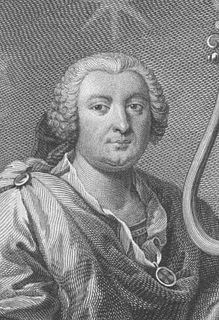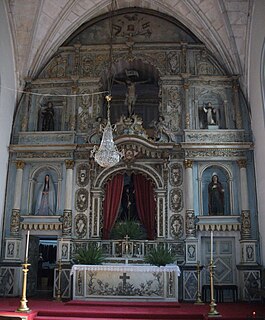Related Research Articles

Dom Joseph I, known as "The Reformer", was King of Portugal from 31 July 1750 until his death. Among other activities, Joseph was devoted to hunting and the opera. Indeed, he assembled one of the greatest collections of operatic scores in Europe. His government was controlled by Sebastião José de Carvalho e Melo, 1st Marquis of Pombal.

Dona Maria I was Queen of Portugal from 24 February 1777 until her death in 1816. Known as Maria the Pious in Portugal and Maria the Mad in Brazil, she was the first undisputed queen regnant of Portugal and the first monarch of Brazil.

The Most Serene House of Braganza, also known as the Brigantine Dynasty, is a dynasty of emperors, kings, princes, and dukes of Portuguese origin which reigned in Europe and the Americas.

José António Carlos de Seixas was a pre-eminent Portuguese composer of the 18th century. An accomplished virtuoso of both the organ and the harpsichord, Seixas succeeded his father as the organist for Coimbra Cathedral at the age of fourteen. In 1720, he departed for the capital, Lisbon, where he was to serve as the organist for the royal chapel, one of the highest offices for a musician in Portugal, a position which earned him a knighthood. Much of Seixas' music rests in an ambiguous transitional period from the learned style of the 17th century to the galant style of the 18th century.

The Monastery of Batalha is a Dominican convent in the municipality of Batalha, in the district of Leiria, in the Centro Region of Portugal. Originally, and officially, known as the Monastery of Saint Mary of the Victory, it was erected in commemoration of the 1385 Battle of Aljubarrota and would serve as the burial church of the 15th-century Aviz dynasty of Portuguese royalty. It is one of the best and original examples of Late Flamboyant Gothic architecture in Portugal, intermingled with the Manueline style.

DomDuarte Nuno, Duke of Braganza was the claimant to the defunct Portuguese throne, as both the Miguelist successor of his father, Miguel, Duke of Braganza, and later as the head of the only Brigantine house, after the death of the last Legitimist Braganza, King Manuel II of Portugal. In 1952, when the Portuguese Laws of Banishment were repealed, the Duke moved his family to Portugal, thus returning the Miguelist Braganzas to their homeland and becoming the first of the former Portuguese royal dynasty to live in Portugal since the abolition of the monarchy, in 1910.
Being one of the most ancient nation-states in Europe, Portugal is proud of its long music history, which accompanied and strongly contributed to the development of the outstanding music history in Europe.

Mafalda of Portugal was a Portuguese infanta, the fourth legitimate child and third daughter of Afonso Henriques and his wife Mafalda of Savoy.
The Camões family were descendants of the 14th-century Portuguese nobleman Vasco Pires de Camões.

The War of the Portuguese Succession, a result of the extinction of the Portuguese royal line after the Battle of Alcácer Quibir and the ensuing Portuguese succession crisis of 1580, was fought from 1580 to 1583 between the two main claimants to the Portuguese throne: António, Prior of Crato, proclaimed in several towns as King of Portugal, and his first cousin Philip II of Spain, who eventually succeeded in claiming the crown, reigning as Philip I of Portugal.

The House of Abrantes descends from the ancient and noble Almeida family.

The Bemposta Palace, also known as the Paço da Rainha, is a neoclassical palace in the area of Bemposta, now the civil parish of Pena, in Lisbon. It was originally built for Queen Dowager Catherine of Braganza on her return from London to Lisbon and served for many years as her residence. It was then transferred to the Casa do Infantado, before becoming the residence of John VI of Portugal until his death. After Queen Maria II of Portugal transferred its title to the Army, it became the Portuguese Military Academy.

The Pantheon of the House of Braganza, also known as the Pantheon of the Braganzas, is the final resting place for many of the members of the House of Braganza, located in the Monastery of São Vicente de Fora in the Alfama district of Lisbon, Portugal. The pantheon's burials have included Portuguese monarchs, Brazilian monarchs, a Romanian monarch, queen consorts of Portugal, and notable Infantes of Portugal, among others.
Marcos Soares Pereira, was a Portuguese composer and mestre da Capela Real. He was the brother of the famous Portuguese composer João Lourenço Rebelo.

The Chapel of D. Fradique is a chapel located in the Convent of São Francisco, in the civil parish of Estremoz, in the municipality of Estremoz, in the Portuguese district of Évora.

The Castle of Avis, is a Portuguese medieval castle in civil parish of Avis, in the municipality of the same name, in the Alentejo district of Portalegre.

The Castle of Noudar, is a Portuguese medieval castle in the civil parish and municipality of Barrancos, in the district of Beja.

José Joaquim dos Santos was a Portuguese music teacher and late Baroque-period composer who specialised in writing sacred music. He was listed by two authors as being among Portugal's "most outstanding eighteenth-century composers."

The Royal Patriarchal Music Seminary of Lisbon was founded in 1713 by Portugal's king João V (John) to train singers for his Royal Chapel of Saint Thomas at Ribeira Palace.

The Exchange of the Princesses refers to the ceremonies of the double marriage of Spanish Infanta Mariana Victoria of Spain to the heir of the Portuguese throne, Joseph, Prince of Brazil, and of her older half-brother Ferdinand, Prince of Asturias to Joseph's sister the Infanta Barbara of Portugal, in January 1729.
References
- ↑ The Royal Chapel in the Time of the Habsburgs: Music and Court Ceremony in Early Modern Europe ed. Juan José Carreras López, Bernardo José García García, Tess Knighton - 2005- Page 20 "... the structural comparison between the Portuguese Capela Real under Joao V and the Spanish case could reveal some interesting views, ... See M. C. Brito, 'Scarlatti e la musica alla cortedi Giovanni Vdi Portogallo', Chigiana 60 (1985), pp. (?)"
- ↑ Dennis Shrock Choral Repertoire 2009 - Page 221 "Domenico Scarlatti...and from 1719 until his death he served as mestre de capela at the Royal Chapel in Lisbon, Portugal, where his responsibilities consisted of teaching the Infanta Maria Barbara and the king's younger brother, Don Antonio."